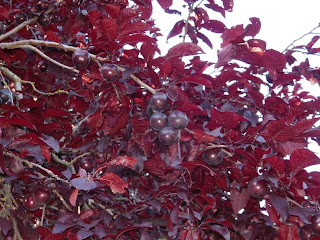Our street is lined with Thundercloud plum trees. Some of them even bear fruit. My next door neighbor's tree is a heavy fruit bearer. Each year the neighborhood kids congregate to pick most of the low hanging plums....usually long before they are ripe. However this year they missed one large area.
I asked my neighbor if it would be OK if I pick them and attempt to make some wine. He doesn't do anything with them so was happy to oblige. I have a huge container of generic honey that I need to use up. I prefer my bees' honey for eating but this generic stuff is fine for mead making. For those who don't know mead is wine made from honey instead of sugar. And melomel is a fruit mead. Here is the recipe I am using, in case anyone else has access to Thundercloud plums. I can't promise the wine will be any good, though, as this is my first attempt at this wine flavor.
Thundercloud Plum Melomel
· 2 # honey
· 1/2 tsp. acid blend
· 1/2 tsp. pectic enzyme
· 1 tsp. nutrient
· 1 campden tablet, crushed
· package wine yeast (or 1/4 tsp in starter)
Wine begun 7-30-13.
Step 1: Pick and wash plums. Break them open with your fingers. Don't remove pits yet. Place into a must bag. Squeeze out as much juice as you can into the primary fermenter. This will also free up the pits. Remove pits from must bag.
Step 2: Add all remaining ingredients except the yeast. Add enough water to make one gallon. Make sure to allow for the weight of the must bag.
Step 3: Take the specific gravity. You are aiming for a beginning SG of 1.090. Mine was spot on.
Step 4: Top with a kitchen towel or cotton cloth and secure with a rubber band. Let sit for 24 hours. This gives the campden tablet time to kill off any wild yeasts that were present on the plum skins, and then gas off. You don't want it to kill your wine yeast.
Meanwhile prepare a yeast starter.
Yeast starter: 1/4 cup warm water, 1 tsp. sugar, 1/4 tsp. wine yeast, 1/4 tsp. yeast nutrient. Cover loosely and let sit until ready to pitch. This will give your yeast a big head start.
Step 5: After 24 hours pitch the yeast into the juice mixture and replace the cloth cover.
Step 6: Stir daily and squeeze juice from the bag. On the 3rd day check the SG. if it is 1.040 or above, rack to the secondary fermenter and attach airlock. While in the secondary it is important to keep the wine out of the light. Cover it with a thick towel or store it in a dark cupboard or closet.
Step 7: Rack again in 3 to 4 weeks. Then rack every 2 months, as needed, until there is no more sediment.
If you don't rack this often, nothing bad will happen. It's best not to have the wine sit on the lees (sediment) for too long but wine does OK if you ignore it. Just check the airlock often and replace the liquid (water or sanitizer) if it gets low.
Step 8: Bottle. I usually keep my wine in the secondary for 9 to 12 months before bottling.
I like to back sweeten my fruit wines at bottling. I add a cup of sugar (or honey) per gallon of wine, give or take. Dissolve the honey or sugar in water before adding. If you sweeten your wine you will also need to add a stabilizer or it might begin fermenting again and you'll have a mess when the corks pop or the bottles explode. Add 1/2 tsp. of stabilizer when you sweeten, then bottle.









No comments:
Post a Comment